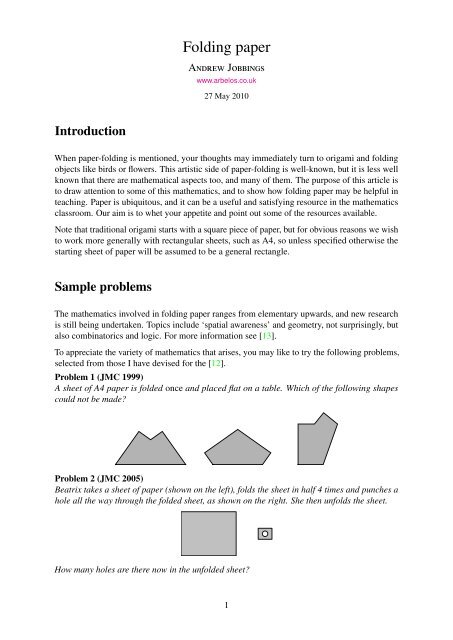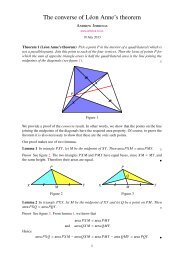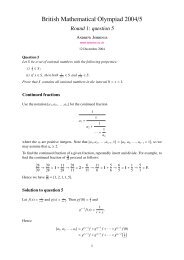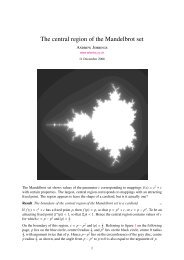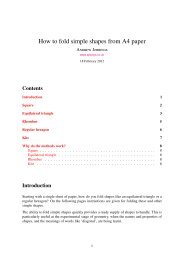Folding paper - Arbelos
Folding paper - Arbelos
Folding paper - Arbelos
You also want an ePaper? Increase the reach of your titles
YUMPU automatically turns print PDFs into web optimized ePapers that Google loves.
<strong>Folding</strong> <strong>paper</strong>Andrew Jobbingswww.arbelos.co.uk27 May 2010IntroductionWhen <strong>paper</strong>-folding is mentioned, your thoughts may immediately turn to origami and foldingobjects like birds or flowers. This artistic side of <strong>paper</strong>-folding is well-known, but it is less wellknown that there are mathematical aspects too, and many of them. The purpose of this article isto draw attention to some of this mathematics, and to show how folding <strong>paper</strong> may be helpful inteaching. Paper is ubiquitous, and it can be a useful and satisfying resource in the mathematicsclassroom. Our aim is to whet your appetite and point out some of the resources available.Note that traditional origami starts with a square piece of <strong>paper</strong>, but for obvious reasons we wishto work more generally with rectangular sheets, such as A4, so unless specified otherwise thestarting sheet of <strong>paper</strong> will be assumed to be a general rectangle.Sample problemsThe mathematics involved in folding <strong>paper</strong> ranges from elementary upwards, and new researchis still being undertaken. Topics include ‘spatial awareness’ and geometry, not surprisingly, butalso combinatorics and logic. For more information see [13].To appreciate the variety of mathematics that arises, you may like to try the following problems,selected from those I have devised for the [12].Problem 1 (JMC 1999)A sheet of A4 <strong>paper</strong> is folded once and placed flat on a table. Which of the following shapescould not be made?Problem 2 (JMC 2005)Beatrix takes a sheet of <strong>paper</strong> (shown on the left), folds the sheet in half 4 times and punches ahole all the way through the folded sheet, as shown on the right. She then unfolds the sheet.How many holes are there now in the unfolded sheet?1
www.arbelos.co.uk/<strong>paper</strong>s.html © Andrew Jobbings 2010Problem 3 (JMC 2001)The sheet of <strong>paper</strong> shown on the left is folded along the dotted lines (each fold being eitherforwards or backwards) to make the leaflet shown on the right. Each of the six ‘pages’ of theleaflet is printed in a different colour. No matter how it is folded, the leaflet will have two pagesvisible on the outside.foldHow many different pairs of outside pages can be obtained by folding the sheet of <strong>paper</strong> indifferent ways?Problem 4 (IMC 1999)A rectangular sheet of <strong>paper</strong> with sides 1 and √ 2 has been folded once as shown, so that onecorner meets the opposite long edge. What is the value of the length d?d√21Simple shapesOn the way to learning about Euclidean geometry in a more formal way, pupils pass through a‘scientific’ or experimental stage, where they use processes such as observation and classificationto develop their understanding of geometrical objects. During this formative phase, practicalmethods like <strong>paper</strong> folding are very appropriate.As an example, see the instructions for folding a rhombus given on the following page. Thisis one of several shapes included in the <strong>paper</strong> How to fold simple shapes from A4 <strong>paper</strong> [8],which is freely available and discusses the folding methods in more detail. Included there is aproof that the rhombus has angles of 60° and 120°. These special angles mean that folding therhombus in half gives an equilateral triangle; alternatively, making two different folds creates aregular hexagon.The ‘model’ may be used in the classroom to demonstrate some of the properties of a rhombusin a practical way—folding in half, say, to show that pairs of sides are equal, or that a diagonalbisects the angle at a vertex. This can all be done without measurement, since the lengths orangles actually coincide on the model. Similarly, showing that the diagonals are perpendicularjust requires the two diagonals to be folded: can you see how to confirm, without measuring,that the angle between the diagonals is 90°?2
www.arbelos.co.uk/<strong>paper</strong>s.html © Andrew Jobbings 2010To fold a rhombusDCDCMMAStep 1Fold a sheet of A4 <strong>paper</strong> in half widthwiseand unfold.BAStep 2Fold AB and CD onto the crease from Step1 and unfold.BDCDC ′MB ′AStep 3Fold B onto the lower crease from Step 2so that the new crease passes through M;repeat with C and the upper crease.BAStep 4Fold A onto the lower crease from Step 3so that the new crease passes through B ′ ;repeat with D, the upper crease and C ′ .The completed rhombus.3
www.arbelos.co.uk/<strong>paper</strong>s.html © Andrew Jobbings 2010GeometryWhen you tried Problem 4 you probably made use of Pythagoras’ theorem and it is perhapsnot surprising that Pythagoras is involved for a configuration of this type. For another example,consider figure 3, which shows a square sheet folded so that the lower left corner meets themidpoint M of the top edge. Where are the fold points on the side edges? The required pointsmay be obtained using Pythagoras’ theorem. Observe that 3-4-5 triangles make an appearance!MFigure 3: <strong>Folding</strong> a square.The result generalises: instead of dividing the top edge in the ratio 1 : 1, consider the casewhere M divides the edge in the ratio p : q. The resulting configuration is known as Haga’sconstruction, which may be used, repeatedly, to divide the side of a square in any ratio. SeeLang’s article ‘Origami and Geometric Constructions’ [9] for a full discussion of this and similarresults.Anyone familiar with classical ‘straightedge and compass’ constructions may be surprised tolearn that everything that can be constructed in the classical way may also be achieved byfolding <strong>paper</strong>, indeed, even more is possible by <strong>paper</strong>-folding than by classical constructions.For example, a given angle may be trisected (see figure 4), something that is not possible withstraightedge and compass. Angle trisection is incorporated in the classroom activity <strong>Folding</strong>Curves and Thirds [5]; a proof of the construction is given in the accompanying Teacher’sNotes.The book Geometric Origami [4] includes a full discussion of <strong>paper</strong>-folding constructions andgives folding instructions for several regular polygons, such as the heptagon, known not to beconstructible in the traditional way.ApplicationsThe beginning of this article referred to origami as the artistic side of <strong>paper</strong>-folding. Recently theuse of mathematics—specifically, ideas related to circle packing—has led to significant developmentsin origami art, by helping to answer the question “how do you create a crease pattern fora given origami object?” The same work has led to developments in engineering and medicinetoo, amongst other fields. For a description of applications to stents and space telescopes, forexample, see [11]. A remarkable 16-minute video [10] describes several applications: to a TVadvert, telescopes, airbags and stents, as well as to origami itself.5
www.arbelos.co.uk/<strong>paper</strong>s.html © Andrew Jobbings 2010APT(a) The given angle A.ReferencesC(b) Fold up bottom edge to maketwo equally spaced creases.Figure 4: Trisecting an angle.C(c) Fold up so that C lies on firstcrease and P lies on givenline. CT is the line oftrisection.[1] Devin J. Balkcom et al. ‘<strong>Folding</strong> Paper Shopping Bags’. In: Origami 4 : Proceedings ofthe 4th International Meeting of Origami Science, Math, and Education.A K Peters, 2006, pp. 315–334.url: http://erikdemaine.org//<strong>paper</strong>s/PaperBag_OSME2006/.[2] Erik Demaine and Martin Demaine. Erik Demaine and Martin Demaine’s Puzzles. 2010.url: http://erikdemaine.org/puzzles/.[3] <strong>Folding</strong> Paper in Half 12 Times. The Historical Society of Pomona Valley.url: http://www.pomonahistorical.org/12times.htm.[4] Robert Geretschläger. Geometric Origami. <strong>Arbelos</strong>, 2008. isbn: 978-0-9555477-1-3.url: http://www.arbelos.co.uk/GeometricOrigami.html.[5] Andrew Jobbings. <strong>Folding</strong> Curves and Thirds. ClubMaths 17. 2006.url: http://www.arbelos.co.uk/clubmaths.html.[6] Andrew Jobbings. <strong>Folding</strong> Stamps and Maps. ClubMaths 23. 2006.url: http://www.arbelos.co.uk/clubmaths.html.[7] Andrew Jobbings. Fractals. The Beauty of Mathematics poster collection. 2007.url: http://www.arbelos.co.uk/posters.html.[8] Andrew Jobbings. How to fold simple shapes from A4 <strong>paper</strong>. 2010.url: http://www.arbelos.co.uk/<strong>paper</strong>s.html.[9] Robert J. Lang. ‘Origami and Geometric Constructions’. 2003.url: http://www.langorigami.com/science/hha/hha.php4.[10] Robert J. Lang. Robert Lang folds way-new origami. TED. 2008. url: http://www.ted.com/index.php/talks/robert_lang_folds_way_new_origami.html.[11] Tom Shelley. Expanding structures reach out to save lives. 2005.url: http://www.eurekamagazine.co.uk/article/3274/Expandingstructures-reach-out-to-save-lives.aspx.6
www.arbelos.co.uk/<strong>paper</strong>s.html © Andrew Jobbings 2010[12] United Kingdom Mathematics Trust. url: http://www.mathcomp.leeds.ac.uk/.[13] Wikipedia contributors. Mathematics of <strong>paper</strong> folding.url: http://en.wikipedia.org/wiki/Mathematics_of_<strong>paper</strong>_folding.AnswersProblem 1: all are possible.Problem 2: 16.Problem 3: 6.Problem 4:√2 − 1.7


